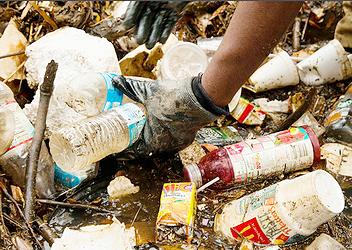
RICHLAND, Washington, June 4, 2019 (ENS) – Scientists have found a way to turn daily-use plastic waste products into jet fuel. In a method described in a new paper in the journal “Applied Energy,” a research group led by Washington State University Associate Professor Hanwu Lei melted plastic waste at a high temperature with activated carbon to produce jet fuel.
“Waste plastic is a huge problem worldwide,” said Lei, with WSU’s Department of Biological System Engineering. “This is a very good, and relatively simple, way to recycle these plastics.”

The U.S. Environmental Protection Agency says that landfills across the country received 26 million tons of plastic in 2015, the most recent year statistics are available. China has recently stopped accepting plastics for recycling from the United States and Canada.
China’s ban, which took effect January 1, 2018, covers imports of 24 kinds of solid waste, including low-grade polyethylene terephthalate used in plastic bottles.
China had been processing at least half of the world’s exports of waste paper, metals and used plastic – 7.3 million tons in 2016.
Now, conservative estimates by scientists say that at least 4.8 million tons of plastic enter the oceans each year worldwide.
In the experiment, Lei and his colleagues tested low-density polyethylene. They mixed a variety of waste plastic products, like water bottles, milk bottles, and plastic bags, and ground them down to the size of rice grains.
The plastic granules were then placed on top of activated carbon in a tube reactor at a high temperature, ranging from 430 degrees Celsius to 571 degrees Celsius. That’s 806 to 1,060 degrees Fahrenheit.
The carbon is a catalyst – a substance that speeds up a chemical reaction without being consumed by the reaction.
“Plastic is hard to break down,” Lei said. “You have to add a catalyst to help break the chemical bonds. There is a lot of hydrogen in plastics, which is a key component in fuel.”
Once the carbon catalyst has done its work, it can be separated out and re-used on the next batch of waste plastic conversion. The catalyst can also be regenerated after losing its activity.
After testing several different catalysts at different temperatures, their best result produced a mixture of 85 percent jet fuel and 15 percent diesel fuel.

“We can recover almost 100 percent of the energy from the plastic we tested,” Lei said. “The fuel is very good quality, and the byproduct gases produced are high quality and useful as well.”
Lei said the method for this process is easily scalable. It could work at a large facility or on farms, where farmers could turn plastic waste into diesel.
“You have to separate the resulting product to get jet fuel,” Lei said. “If you don’t separate it, then it’s all diesel fuel.”
Professor Lei’s efforts to create an environmentally friendly catalyst that could lower the cost and increase the efficiency in producing bio-based jet fuels yielded him and his colleagues a $500,000 grant last year from the National Institute of Food and Agriculture, U.S. Department of Agriculture.
Lei and his team will use enzymes to produce nanocrystalline cellulose, a catalyst. “Green catalysts” will be created from wastes such as corn stover, a remnant of corn harvest, or sawdust from Douglas fir trees. The new nano carbon catalyst is expected to create cycloalkane naphtha, a major component in jet fuels.
“To reduce energy and hydrogen demands, and improve the catalytic performance of bio-jet fuel production, we proposed a new catalyst design that we could leverage from environmentally friendly, nature-based molecules,” Lei said. “These rod-like nanocrystals can be sourced from any agroforestry waste.”
Lei said, “The new process provides another novel pathway for conversion of biomass into advanced biofuels and jet fuels.”
Copyright Environment News Service (ENS) 2019. All rights reserved.
© 2019, Environment News Service. All rights reserved. Content may be quoted only with proper attribution and a direct link to the original article. Full reproduction is prohibited.
